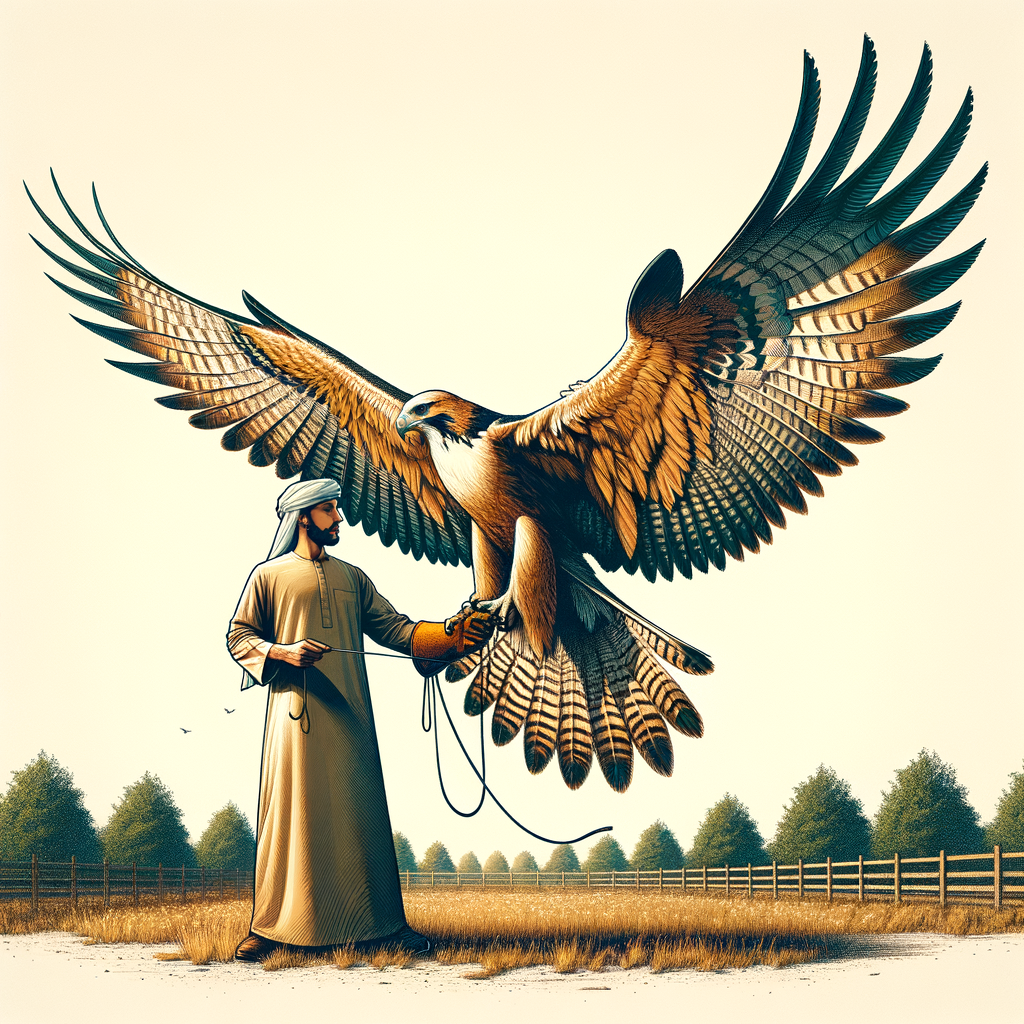Mastering Longwing Techniques
- Understand Longwing Raptors: Focus on species like the Peregrine Falcon and Gyrfalcon, known for their speed and hunting skills.
- Training Basics: Start with building trust and a strong bond using positive reinforcement and consistent routines.
- Manning and Initial Handling: Begin by getting the bird accustomed to your presence and handling it slowly and gently.
- Lure Training Techniques: Use a lure (a piece of food attached to a line) to teach the bird to chase and return to you. This simulates hunting and keeps them in good shape.
- Flight Conditioning: Regularly fly your bird to improve stamina, speed, and agility. This can involve free flight sessions or use of a creance line for controlled flight.
- Hunting Practices: Longwings primarily hunt birds in flight. Plan hunts in open areas where your bird can spot prey from a distance and dive at high speeds.
- Health and Nutrition: Maintain a balanced diet suited to the species and regularly check for signs of illness. Good health is crucial for peak performance.
- Record Keeping: Document your bird’s progress, health, and behavior changes to track improvements and adjust techniques as needed.
- Legal and Ethical Considerations: Always follow local wildlife laws and ethical guidelines in falconry practices to ensure the well-being of birds and their environment.
- Continuous Learning: Stay updated on new techniques and knowledge by joining falconry clubs, attending workshops, and reading up-to-date resources.
By integrating these methods, you’ll ensure a successful and ethical falconry experience with your longwing raptors. Happy flying!
Soaring into the Art of Longwing Techniques
Top o’ the morning to ya! Welcome to a journey that’s as captivating as a crisp morning in the Irish countryside. Here at Learn Falconry, we believe that understanding the ancient and skillful art of longwing techniques in falconry is akin to mastering a traditional Irish dance’complex, graceful, and incredibly rewarding. But that’s not where our story ends; it’s just the beginning!
Have you ever seen a bird of prey soaring with the elegance of an Irish jig, weaving through the air with the precision and grace of a seasoned dancer? That’s what mastering longwing techniques can feel like. These techniques are essential not just for the expert falconer, but also for those new to the world of falconry who want to elevate their skills and bond with these majestic birds.
Now, why is it so important to keep reading? Because, just as no one would leave an Irish dance before the end, you wouldn’t want to miss the secrets and insights that await you! We’ll delve into the nitty-gritty of these techniques and share why they’re the cornerstone of successful falconry. So grab your favorite cozy seat and get ready to be enchanted. Yes, it’s going to be an incredible flight!
Exploring Longwing Techniques in Falconry
Welcome to the fascinating world of longwing falconry! If you’re passionate about learning the intricacies of training and flying these majestic birds, you’re in the right place. In this article, we’ll dig deep into longwing methods, providing detailed insights and explanations to help you master these advanced falconry techniques.
Understanding Longwing Falconry
Longwing falconry refers to the art of training and flying falcons known for their long wings and high-speed hunting. These birds, such as Peregrine Falcons, Gyrfalcons, and Saker Falcons, are known for their incredible speed and agility. To get a better understanding of the different species of falcons used in longwing falconry, visit our Species of Falcons page.
Essential Longwing Techniques
Longwing techniques are varied and require patience and skill. Here are some key methods:
Waiting on Style
One of the classic methods in longwing falconry is the “waiting on style.” In this technique, the falcon soars at a high altitude, waiting for the falconer to flush prey into the open. The falcon then dives down at incredible speeds to capture the prey. This method showcases the bird’s natural hunting abilities and sharp vision, making it an exhilarating experience for both the falconer and the bird.
Lure Flying
Lure flying is another crucial technique in longwing methods. It involves the use of a weighted lure, mimicking the prey, which the falcon is trained to chase and catch. This training method helps in honing the bird’s hunting skills and ensuring they stay fit and agile. For more about different types of lures, check out our page on Falconry Lures.
Manning
Manning or the process of taming and acclimating the bird to human presence is fundamental in longwing falconry. It involves handling the bird regularly, feeding it from the glove, and ensuring it becomes comfortable around the falconer. This step is crucial for building a strong bond between the falcon and its handler. Learn more about this technique on our Manning Techniques page.
Advanced Longwing Methods
After mastering the basic techniques, falconers can move on to more advanced longwing methods. These include:
High-Altitude Training
Training falcons to fly and hunt at high altitudes is an advanced skill in longwing falconry. This requires the bird to gain and maintain a significant height before diving at the prey, often leading to spectacular stoops at high speeds. This method demands meticulous training and precise timing. For more comprehensive training tips, explore our Advanced Falconry Techniques.
Cooperative Hunting
In cooperative hunting, multiple falcons are flown together to hunt larger prey. This technique is challenging as it requires the birds to work together and respond to the falconer’s commands simultaneously. Cooperative hunting showcases the harmony between the falconer and the birds, as well as the coordination among the falcons themselves. To delve deeper, visit our section on Cooperative Hunting Methods.
Longwing Equipment and Care
Proper equipment and care are crucial for any successful falconry practice. Essential longwing falconry gear includes hoods, gloves, and telemetry devices. Ensuring the health and nutrition of the falcons is also vital. Regular health check-ups, proper diet, and hydration are necessary to keep the birds in peak condition. Discover more about the necessary equipment on our Falconry Equipment page and read up on health tips in our Falcon Health & Nutrition section.
Understanding legal aspects is equally important to ensure compliance with regional and international laws concerning falconry. For detailed information on regulations, you can check our Legal Aspects of Falconry page.
By mastering these longwing techniques and understanding the responsibilities that come with falconry, enthusiasts can truly appreciate this ancient practice. With dedication and respect for the craft, you’ll develop a strong and rewarding relationship with your falcon. To learn more about the history of falconry and its evolution, visit our History of Falconry page.
Embark on your journey with longwing falconry today and experience the thrill of flying high with your feathered companion!
In-Depth Guide to Longwing Techniques in Falconry
Falconry Permit Requirements
If you want to practice longwing falconry, obtaining a permit is crucial. In 2024, the process to get this permit includes passing a written examination with at least an 80% score and having an Arkansas hunting license. This ensures that only knowledgeable and responsible individuals can engage in falconry.
Wild Bird Capture Rules
Capturing wild birds for falconry involves specific guidelines:
- A General or Master falconer must be at the capture site.
- The person who captures the bird must report it within five days.
- The bird caught counts towards the captor’s annual limit.
Banding Raptors
Banding is essential for tracking and identification. Raptors, such as goshawks, Harris hawks, peregrine falcons, and gyrfalcons, must be banded or microchipped. This must be done within ten days of capture or rehabilitation.
| Raptor Species | Banding Options |
|---|---|
| Goshawks | Permanent, non-reusable USFWS leg band |
| Harris hawks | Permanent, non-reusable USFWS leg band |
| Peregrine falcons | Permanent, non-reusable USFWS leg band |
| Gyrfalcons | ISO-compliant microchip or USFWS leg band |
Reporting Requirements
All activities involving falconry raptors must be reported within ten business days. This includes capturing wild birds, acquiring new birds, transferring birds, banding, and any loss or recapture of birds. A completed Form 3-186A must be submitted along with entering the data into an electronic database.
Unintentional Prey Take
Occasionally, a falconry raptor might unintentionally catch prey, including those that are federally protected:
- These accidental captures must not be kept.
- Report any capture of federally listed threatened or endangered species within 48 hours.
Summary of Key Points
| Aspect | Requirement |
|---|---|
| Permit Examination | Pass with at least 80%, Arkansas hunting license required |
| Wild Bird Capture | General/Master falconer must be present, report within 5 days |
| Band Requirements | Band/microchip within 10 days, report to USFWS and AGFC |
| Activity Reporting | Report within 10 business days, submit Form 3-186A |
| Unintentional Take | Must not keep, report capture of protected species within 48 hours |
These points are designed to ensure responsible falconry practices and to protect bird populations, making falconry an art that balances tradition with duty.
Key Takeaways for Longwing Techniques in 2024
As we look ahead to 2024, the world of longwing falconry is shaped by important regulations and necessary practices to ensure the best care and handling of these magnificent birds. Here are the most critical points to remember:
- Falconry Permit Requirements: You must pass a written exam and hold a hunting license to get a falconry permit.
- Capturing Wild Birds: Only experienced falconers can capture wild birds, and any capture must be reported within five days.
- Band Requirements: Raptors from the wild or rehabilitation centers must be banded or microchipped, with all details reported to relevant wildlife services.
- Reporting Activities: Any activities involving falconry raptors, from acquisition to loss, must be documented and reported within 10 business days.
- Handling Unintentional Take: If a raptor unintentionally takes prey, it must not be kept, especially if it’s a protected species.
These guidelines help ensure responsible and ethical practice in longwing falconry, promoting the well-being of both birds and the environment. Whether you are an aspiring falconer or an experienced one, staying informed and compliant with these practices will help maintain the integrity and tradition of falconry.



